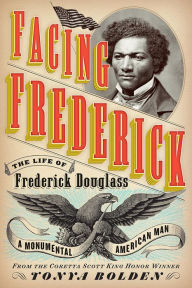Facing Frederick Tells the Story of A Monumental American Man

As the mother of a biracial teen whom I raised as a single parent, I know little about her birth father’s ancestry, so when my daughter wanted to get a DNA test recently, I was thrilled. It has been fascinating for both of us to follow the map of her ancestry from Africa to the southern United States.
During this time, I got the chance to read Facing Frederick: The Life of Frederick Douglass, a Monumental American Man, and I was equally fascinated to learn more about this mighty abolitionist, activist, publisher, diplomat to Haiti, and prolific writer.
Facing Frederick: The Life of Frederick Douglass, a Monumental American Man
Facing Frederick: The Life of Frederick Douglass, a Monumental American Man
By Tonya Bolden
In Stock Online
Hardcover $19.99
Author Tonya Bolden’s detailed research—including an author’s note about her private tour of his home—comes through, as does her captivation with Frederick. Her goal in this book is very clear: to show young people that Douglass was so much more than “an escaped slave.” After all, all his life, this is what Frederick himself wanted.
Author Tonya Bolden’s detailed research—including an author’s note about her private tour of his home—comes through, as does her captivation with Frederick. Her goal in this book is very clear: to show young people that Douglass was so much more than “an escaped slave.” After all, all his life, this is what Frederick himself wanted.
What I appreciate most about this biography is its focus on Frederick as a human being, instead of him as an historical icon. It’s an intricate portrait of a real individual with a complicated life story. What most fascinated me were Frederick’s relationships with the women in his life, his first wife Anna Murray and his second wife Helen Pitts.
Frederick “wrote very little” about Anna, “a laundress and housekeeper” who was not literate. She was a free black woman who’d given Frederick a disguise (as a free sailor, with a red shirt, blue trousers, and a tarpaulin hat) to help him make “that great escape” that led him to the Underground Railroad and freedom.
Anna was married to Frederick for 44 years, and, reading between the lines of Bolden’s biography, it seems like she raised their five children mostly on her own while he was on the road.
Douglass remarried several years after her death. His second wife, Helen Pitts, was a feminist who was 20 years younger than Frederick, and had the chance to travel to Europe and Egypt with him before he died at age 77. Helen’s white parents refused to let Frederick into their home because “his daughter had married a black man.”
I would love to know more about how both of these women supported Frederick to become so successful in his work, and hope that perhaps Bolden has another book in the works?
The many illustrations, images, and photos of Frederick and his life that this book includes are a enormous added bonus to the story: he remains one of the most photographed figures in American history. This book is perfect for young history enthusiasts who are ready for a nuanced, complex portrait of a fascinating historical figure.
Facing Frederick: The Life of Frederick Douglass, a Monumental American Man is on B&N Bookshelves now.
